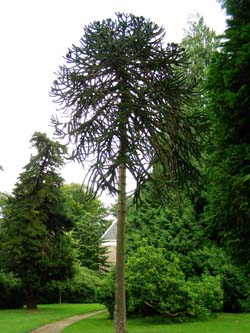The description of Powerscourt in Ireland by its owner turns out to be a vital source of information for anyone interested in how (the garden of) a late 19th century estate was created over a period of decades. Mervyn E. Wingfield mentions many names of gardeners, sculptors, companies that sell or auction statues and seeds, etc. It clearly shows how some choices are very deliberate, and how at the same time some other garden elements are there just because they were available at the right time.
But Wingfield hardly mentions the plants he used. Almost at the end of his description of the terraces he writes:
The pleasure grounds are filled wih many kinds of rare plants and shrubs, many of which would not be hardy in England, but which thrive in the temperate climate of the Green Isle. Rare conifers as well as deciduous trees are scattered through the grounds, and those which I have myself planted are now growing to a considerable size, Wellingtonias, araucarias, and others having reached a height of fifty and sixty feet, and even more, (…). 1Mervyn E. Wingfield, A Description and History of Powerscourt, London (1903), p95. The araucarias he planted himself were in a grove further from the house, near Bahana and Onagh Bridge (op. cit. p107). He planted 100 of them, ‘thinking that in future times his would make a remarkable feature of the place’.
 He then goes on to talk about a few specific plants and species, but I would like to zoom in on the araucarias he mentioned. A few pages earlier he writes about the terrace walk, which he extended to a lentgh of 800 yards (730 meters), running outside the garden at the (south)western end ‘as far as the level ground permitted, to the edge of the slope at the oak-wood called “The Dead Man’s Bank”‘. He placed a statue of Ajax at that end and
He then goes on to talk about a few specific plants and species, but I would like to zoom in on the araucarias he mentioned. A few pages earlier he writes about the terrace walk, which he extended to a lentgh of 800 yards (730 meters), running outside the garden at the (south)western end ‘as far as the level ground permitted, to the edge of the slope at the oak-wood called “The Dead Man’s Bank”‘. He placed a statue of Ajax at that end and
(…) planted an avenue of araucarias and abies Douglasii from the part where the garden terminates to this statue. 2op. cit., p90.
I know Wingfield was proud of the variety of plants that thrived in his garden. But combining Araucaria araucana and Pseudotsuga menziesii (‘abies Douglasii’ is a synonym) seems like stretching things to their limit. I would at least never have thought of this combination if I were asked to plant an avenue of mixed evergreens in a period garden, and know of no other examples.
Footnotes
| ↑1 | Mervyn E. Wingfield, A Description and History of Powerscourt, London (1903), p95. The araucarias he planted himself were in a grove further from the house, near Bahana and Onagh Bridge (op. cit. p107). He planted 100 of them, ‘thinking that in future times his would make a remarkable feature of the place’. |
|---|---|
| ↑2 | op. cit., p90. |


